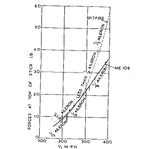KraziKanuK
Banned
- 792
- Jan 26, 2005
DerAdlerIstGelandet said:Yes most accidents in the 109 (all varients) were on the landing due to the narrow landing gear track.
You do know that the Spit had a narrower track than the 109?
What caused the 109 accidents was the toe-in. If it was not set down square and the pilot had a moment of in-attension, the 109 would vere in the direction opposite to the wheel touching. A ground loop would follow with the forces being too great for the strut to bear, so breaking, if the ground loop was severe enough.

